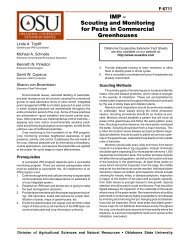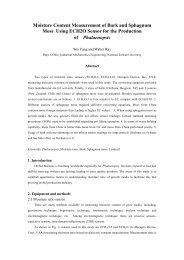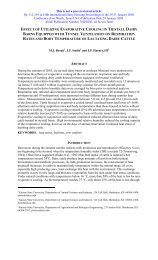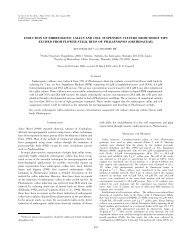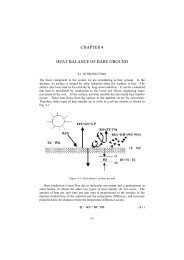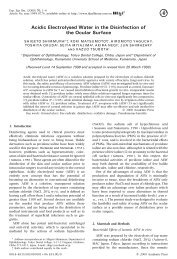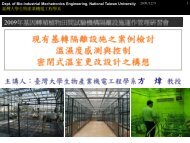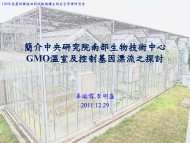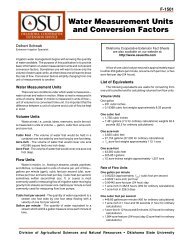Review on thermal energy storage with phase change: materials ...
Review on thermal energy storage with phase change: materials ...
Review on thermal energy storage with phase change: materials ...
- No tags were found...
Create successful ePaper yourself
Turn your PDF publications into a flip-book with our unique Google optimized e-Paper software.
268 B. Zalba et al. / Applied Thermal Engineering 23 (2003) 251–283soluti<strong>on</strong> of <strong>phase</strong> <strong>change</strong> problems into two groups: fixed grid methods based <strong>on</strong> the enthalpyc<strong>on</strong>cept, and moving grid methods utilizing the interface immobilizati<strong>on</strong> technique. Furzerland[127] compared the two methods for the soluti<strong>on</strong> of a specific test problem of <strong>on</strong>e dimensi<strong>on</strong> andheat transfer by pure c<strong>on</strong>vecti<strong>on</strong>. One of this c<strong>on</strong>clusi<strong>on</strong>s is that the enthalpy method is easy toprogram and more suitable for PCM <strong>with</strong> a range of fusi<strong>on</strong> temperatures.3.1.4. Numerical simulati<strong>on</strong> in different heat ex<strong>change</strong>r geometriesDincer and Rosen [4] deal <strong>with</strong> the problems of heat transfer <strong>with</strong> <strong>phase</strong> <strong>change</strong> <strong>materials</strong> insimple and complex geometries and around iso<strong>thermal</strong> finned cylinders. The results are presentedand validated <strong>with</strong> actual and existing data.Lacroix [128,129] solved the problem of fusi<strong>on</strong> in a rectangular cavity including the naturalc<strong>on</strong>vecti<strong>on</strong> effects using a methodology similar to the fr<strong>on</strong>t immobilizati<strong>on</strong> technique. He used asystem of coordinates adjusted to the body obtained normally from the soluti<strong>on</strong> of differentialequati<strong>on</strong>s, where the irregular domain is transformed into a simpler <strong>on</strong>e. As this process is d<strong>on</strong>efor each time interval, an algebraic generator was used for the new system. Later Lacroix andVoller [130] performed a study comparing methods of soluti<strong>on</strong> of <strong>thermal</strong> <strong>phase</strong> <strong>change</strong> problemsin a rectangular cavity. They compared the finite volume method <strong>with</strong> the enthalpic formulati<strong>on</strong>and the method of body-fitted coordinates. As a result they c<strong>on</strong>cluded that the enthalpic methodmay require a fine grid in problems of <strong>phase</strong> <strong>change</strong> in a single temperature (such as water), whilethe limiting factor in the body-fitted coordinate method is the need to use a coordinate generatorat each time increment, which would be complicated in cases of complex geometries.The complexity of the equati<strong>on</strong>s means that the <strong>on</strong>ly generally applicable mathematical approachis that of numerical methods. One of the methods that appears more regularly in theliterature is finite differences. Shamsundar and Sparrow [101,102] apply this method to the resoluti<strong>on</strong>of the enthalpy equati<strong>on</strong> in the solidificati<strong>on</strong> of a flat plate. A much more comprehensivereview of these methods can be found in Shamsundar [99,131,132] where they are applied to thecase of a square geometry.Works by Costa et al. [133] study numerically a two-dimensi<strong>on</strong>al rectangular area, using <strong>energy</strong>equati<strong>on</strong>s in solid and liquid <strong>phase</strong>s, c<strong>on</strong>tinuity, momentum and StefanÕs equati<strong>on</strong> in theboundary. Three PCM are analysed: paraffin (n-octadecanol) and metals (gallium and tin). Theyput forward a numerical resoluti<strong>on</strong> method called SIMPLEC (semi-implicit method for pressurelinkedequati<strong>on</strong>s c<strong>on</strong>sistent) and compare the results <strong>with</strong> those obtained in the literature. In thecase of octadecanol, there is poor agreement <strong>with</strong> the experimental results in the upper z<strong>on</strong>e wherethe liquid which melts at the sides fills the upper empty cavity and accelerates melting in this area.Costa [133,134] indicates that the reas<strong>on</strong>s of the discrepancies between the experimental andtheoretical results are due to <strong>thermal</strong> inertia, instability in the systems, <strong>thermal</strong> losses, lack ofreliable informati<strong>on</strong> about the physical properties of the <strong>materials</strong>, three-dimensi<strong>on</strong>al behaviour,c<strong>on</strong>siderati<strong>on</strong> of c<strong>on</strong>stant thermophysical properties, variati<strong>on</strong>s in density, l<strong>on</strong>g calculati<strong>on</strong> periodsand significant variati<strong>on</strong>s in viscosity <strong>with</strong> the temperature.Another group of articles in the literature simulates the global behaviour of the system, forexample Carey [135] in ‘‘The c<strong>on</strong>trol of ice <strong>storage</strong> systems’’ integrates the behaviour of thebuilding, the <strong>storage</strong> and the cooling machine.As Lacroix states in Dincer and Rosen [4], the mathematical complexity of the heat transfermodels augments as the emphasis is placed <strong>on</strong> the physical phenomena occurring inside the PCM.




